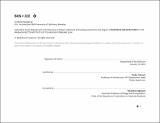Bos > AIR
Author(s)
Lee, Kevin Young
DownloadFull printable version (70.93Mb)
Alternative title
Boston > Airport
Other Contributors
Massachusetts Institute of Technology. Department of Architecture.
Advisor
Nader Tehrani.
Terms of use
Metadata
Show full item recordAbstract
The advent of air travel has produced a building typology completely new to the 20th century. The outdated planning of regions for airports render most existing airports as isolated, autonomous instances in the urban environment barricaded by impenetrable walls of highway infrastructure. The current trend sees a steady rise in air travel at Boston's Logan Airport at a time when, globally, new airports are being planned as new airport city typologies which are becoming increasingly complex programmatically. Furthermore, the different modes of accessing the airport along with the various types of sequencing that occurs throughout the process of air travel creates moments of transitions and intersections of narratives and programs. Dziga Vertov's film Man with a Movie Camera and Jacques Tati's Playtime, though cinematically disparate in technique, both commented on the status of entering a new urban modality and experience during their respective times. The project situates itself in that the urban experience in the 21st century resides in that of the airport, where Marc Augé describes as a "non-place," and a product of "Supermodernity." This thesis looks at rethinking the role of the airport terminal at three scales - the urban potential of a new airport city configuration that can increase the value and promote the growth of East Boston, the typological rethinking of relationships between the disparate airport programs and the infrastructure that supports it, and finally, the influence of cinematic techniques for designing through framed views and the scope of vision. It seeks to blur the thresholds between the public edge of the city and the secure site of the airfield - physically, virtually, visually.
Description
Thesis: M. Arch., Massachusetts Institute of Technology, Department of Architecture, 2014. This electronic version was submitted by the student author. The certified thesis is available in the Institute Archives and Special Collections. Cataloged from student-submitted PDF version of thesis. Includes bibliographical references (page 127).
Date issued
2014Department
Massachusetts Institute of Technology. Department of ArchitecturePublisher
Massachusetts Institute of Technology
Keywords
Architecture.